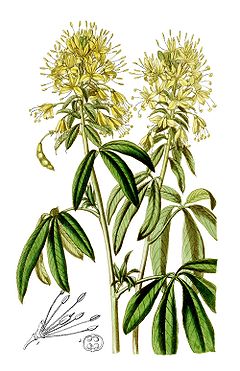- Cleome lutea
-
Cleome lutea 
Golden cleome Scientific classification Kingdom: Plantae (unranked): Angiosperms (unranked): Eudicots (unranked): Rosids Order: Brassicales Family: Cleomaceae Genus: Cleome Species: C. lutea Binomial name Cleome lutea
Hook.Cleome lutea is a species of cleome known by the common names yellow bee plant and yellow spiderflower. This annual wildflower is native to the western United States where it is most common in desert scrub and plateau habitats. It is a sprawling plant often exceeding a meter in height. The erect stem has widely-spaced leaves all the way along, each leaf made up of three to five small leaflets. Atop the stem is a showy inflorescence of many bright yellow flowers. Each flower has oblong petals around a cluster of long stamens tipped with knobby anthers. As the inflorescence lengthens at the top of the stem, flowers that have opened and been pollinated drop their petals and the ovary develops into a fruit. The fruits are capsules several centimeters long containing many seeds. A flowering plant may have blooming flowers at the top of the stem and ripening capsules dangling off the stem further down.
Some Plateau Indian tribes drank an infusion from the branch and flowers of the yellow bee plant as a treatment for the cold.[1]
References
External links

This Brassicales article is a stub. You can help Wikipedia by expanding it.
